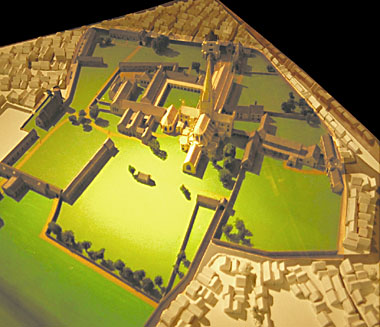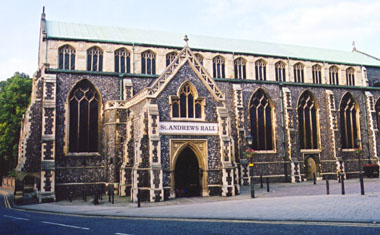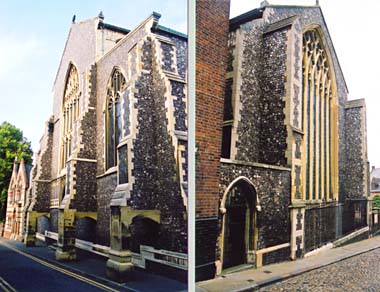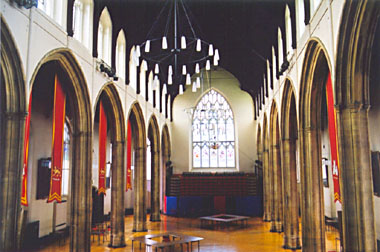
Norwich cathedral-priory's walled precinct,
from a model on display in the cathedral
Photo © S. Alsford
By the mid-fourteenth century, a large portion of the eastern half of intramural Norwich was given over to religious precincts. The cathedral, episcopal palace, and monastery (reconstructed in the model above, although apart from the cloister little still stands of the monastery) consumed the largest area; the western part of which had previously been meadow, but the eastern part had been houses and other buildings in the urban centre of the Anglo-Saxon period. This disturbance of the old town, on top of others by the hated Norman conquerors, and the loss of the marketplace and two churches in the process, established a legacy of resentment that only grew as monks and townspeople clashed over jurisdictional matters.
To the immediate south of the cathedral precinct was the Greyfriars property, and a little further south still that of the Austin friars. On the northern side of the cathedral precinct, in the bend of the River Wensum, was the Great Hospital of St. Giles (see the essay on Retirement}, and just across the river from the cathedral the Whitefriars and Norman's Hospital ate up more urban land.

Norwich Blackfriars
Photo © S. Alsford
The site of the Dominican friary lay west of the cathedral, and stretched from Hungate Street to the south bank of the riverside. The building seen above was the nave of their great church; the church faced onto Hungate and between it and the street was an open area of land the friars used for preaching to audiences. The porch is Victorian.
The Dominicans arrived in Norwich in 1226, establishing their friary on a site north of the river. In 1307 they were able to relocate into buildings formerly occupied by a lesser order, the Friars of the Sack (or Penitentials, one of the orders whose extremist views had been found objectionable by the Church and abolished by the Council of Lyons in 1274). The Blackfriars developed this site into the largest friary complex in the city. Their church was begun in 1326, but not finished until 1470, a fire having destroyed much of the first church in 1413.

(left) West end of the nave, now St. Andrew's Hall
(right) East end of the choir, now Blackfriar's Hall
Photos © S. Alsford
What are now divided into two separate halls were once part of the great church; its nave was also used for the friars to preach to the townspeople, while its choir was a private place of worship for the friars. At the point where nave and choir met, a tower was built in 1462, but has not survived. After the Reformation, the nave was converted into a hall for civic ceremonies, and the choir into a chapel of the civic authorities and gilds. Behind the church were the cloisters and friars' quarters, while further back, on the riverbank, stood the friary brewhouse.

Interior of St. Andrew's Hall, the one-time nave
Photo © S. Alsford
A large part of the cost of building the present hall was paid by Sir Thomas Erpingham, who also funded the building of the main gate into the cathedral close, had served as arbitrator in a political conflict within the city, and was a commander at Agincourt; one of his sons was a friar there. The Paston family contributed to the cost of the roof.